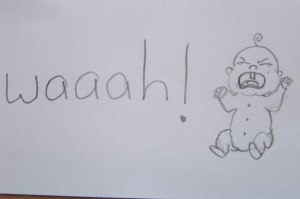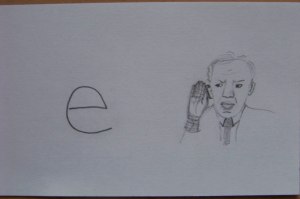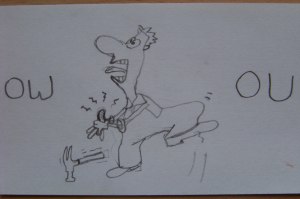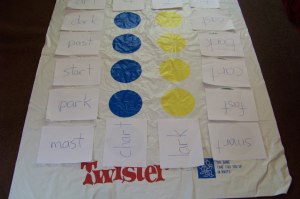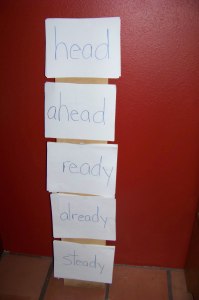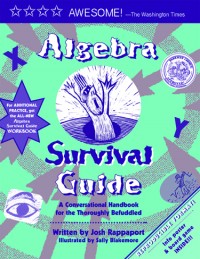Here’s a creative way to help young children understand the difference between addition and subtraction. As I work on math with children in the primary grades, I have observed that while they often have an intuitive grasp of simple mathematics, they don’t connect their understanding to abstract symbols. For example, a child will definitely understand that if his best friend moves away, he has lost one friend. If, however, he sees the math problem 2-1=1, it has no meaning whatsoever.
I try to help children draw a bridge between their innate sense of math gained from real world experiences and math symbols, while also keeping them engaged and focused on the lesson. One powerful way to help focus a young child on the task is by engaging him in a storytelling process. Here’s what I did the other day with an antsy first grader.
Materials: A dry erase board, a range of colorful markers, and some kind of fun manipulatives. I have a set of colorful rubber dinosaurs and another set of cardboard ladybugs.
Activity: I lay my two-foot long dry erase board on the floor and drew a line across the middle of it. I asked the child to draw a dinosaur’s house on the top half of the board. Then I asked him to draw a park on the lower half.
To model what I wanted, I told the first story:
I placed two dinosaurs in the house and put about ten in park. I told the child that the two dinosaurs in the house were getting ready for a big party. They were going to invite some dinosaurs from the park to have supper with them. I asked the boy to move some of the dinosaurs up from the park to the house. He moved about six up to the house. Then I took another dry erase board and asked him to write down the number of the dinos that had been in the house first. He wrote down two. I then asked if he knew what symbol we would use to show that more dinos came to the house. He couldn’t remember, so I drew a plus sign, a minus sign and an equal sign. He then chose the correct symbol. I said, “This plus sign means more dinos came over to the party.” When I asked him to tell me how many dinos there were at the party after six more showed up, he counted all the dinos and told me the correct answer of eight. So I said, “If you have two dinos and six more show up, then the total number of dinos equals eight.” He nodded.
I then continued the story by saying some of the dinos were getting tired and so three of them went back to the park to take a nap.
We then associated each part of the story to the numbers and symbols he used to write an accompanying math sentence. He continually struggled to remember which math symbol stood for plus and which stood for minus.
After modeling a few more “chapters” of the dino party story, I asked the student to be the storyteller. I told him, “You tell me a story that has to do with dinos coming and going, and help me write the math sentences for it.”
That put him in charge, and then the real fun (and probably deeper learning) began.
At first, he couldn’t think of any ideas. So I said, “Well what if the house was haunted?” That unleashed his creative flow. He said, “Seven dinos walked up to the house and they went inside. They wanted to see what was inside.”
I asked, “Was the house empty before they got there?”
When he said yes, I asked, “What number lets us know that no one is there?” He thought for a while and then wrote down a zero.
I asked, “So if six dinos came up from the park, then how would we write that. He put his two fingers together to form a cross and asked, “Is this plus?”. When I affirmed that it was, he wrote it down. When I asked, “So how many dinos showed up at the house?” he wrote down 6. When I asked, “How many dinos altogether,” he understood there were six…although he wasn’t sure how to write the equals symbol.
Then he said, “A ghost jumped out and said boo! Then two dinos got scared and ran back to the park.”
When I asked him to write what he’d just described in a math sentence, he still looked confused. So I broke it down again for him with questions.
1) How many were at the house before the ghost jumped out? He wrote down 6.
2) What’s the symbol you use when dinos leave? He wrote down a minus sign.
3) How many dinos left? He wrote 2.
4) So then how many dinos were still at the house? He said 4.
5) So what’s the symbol you use to show that if you have 6 dinos and 2 leave that 4 are still left? He wrote down the equals sign.
Then he happily made up several more sentences. Here’s one example of what he said. “The two dinos that ran back to the park told the other dinos about the ghost. Then five dinos wanted to see the ghost. They went to the house.”
We stopped to write that part of the story as a math sentence. He continued, “Then a witch came out and said boo! Eight dinos ran away!” He was laughing with delight!
While he was having fun creating stories, he was also slowly infusing the meaning of his stories into what he formerly viewed as meaningless math symbols.
The next time I saw him, he was much faster at applying the correct symbols when he translated his stories into math language. Best of all, the whole experience was fun rather than stressful.

